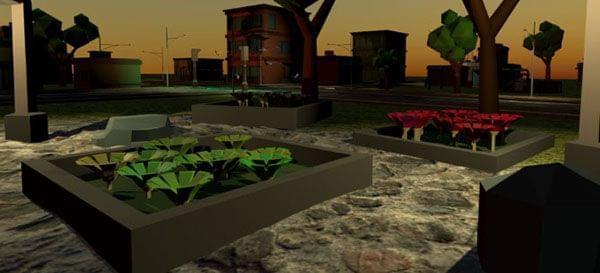How Wearable Technology Can Help Unveil Links Between Exposure To Gun Violence & Health

The flower beds represent the biodata collected from the women. The changing colors of the flowers represent the varying heart rates of the women, collected by wearable sensors. When the flowers are green, it generally means this is an active time for the mothers. Red flowers can represent stress or high levels of activity. Courtesy of National Center for Supercomputing Applications
Research has shown that people who are exposed to gun violence are at greater risk of physical and mental health issues. University of Illinois researchers are looking at the role wearable technology can play in better understanding the link.
Sociologist Ruby Mendenhall is an assistant dean for the Carle Illinois College of Medicine and faculty fellow with the National Center for Supercomputing Applications. She’s been working with research programmers there to carry out a mobile health study.
“This study is part of a much bigger study where we really started to look at how the gun violence affects black mothers’ mental and physical health,” Mendenhall said.
Twelve black women who live in a high-crime neighborhood on Chicago’s south side worked with researchers as “citizen scientists,” Mendenhall said. They wore biosensors, used their cell phones as GPS tracking devices and kept a journal to track their experiences over the course of a month.
“One of the mothers, she was pregnant, the father of her child was killed, she went into labor that same day, and she had preeclampsia, she had seizures, just like a whole cascade of things happened,” Mendenhall said. “And she said, that stress is real and I know because it almost killed me.”
Mendenhall said that first "Chicago Stress Study" was preliminary – and the findings were presented at an exhibit last fall, as part of the Pygmalion Festival in Champaign.
Now she hopes to scale it up to better understand how gun violence affects public health, and what can be done about it.
Follow Christine on Twitter: @CTHerman
Links
- Champaign Community Coalition: Targeted Approach Needed To Address Gun Violence
- Champaign-Urbana Offers ‘Peace Keeper’ Training To Address Gun Violence
- As Shootings Rise, Champaign-Urbana Leaders Grapple With Gun Violence
- How To Stop Gun Violence? Just Ask
- Gun Violence In North And South Peoria; Hate In The Republican Party; Death Penalty
- How Gun Violence Is Traumatizing Kids And What Schools Can Do About It
- Police Data Show Gun Violence A Chronic, Growing Problem Across Illinois

